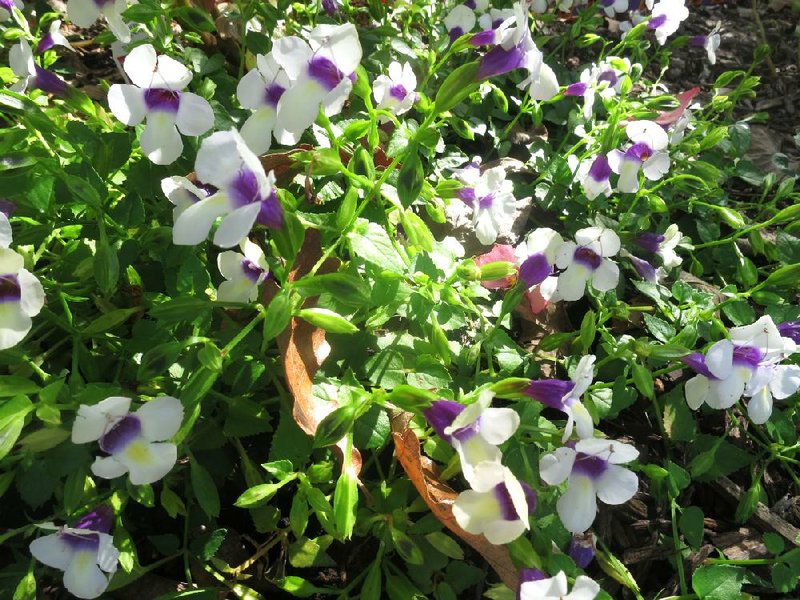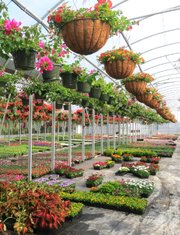Who isn’t anxious to get new color into the garden after the abysmal winter we had? But visiting garden centers can be stressful because there are so many great plants out there - and only so much space to fill at home.
Summer annuals are plants we replant each season. Since they are only around for one part of one year, we want to invest in tough plants that can take an Arkansas summer and still bloom well.
We want to get as much color out of them as we can during their one season of life. Fertilize annuals often throughout that season.
You can use slow-release, fast-release, granular or water-soluble fertilizer, just make sure you use it monthly and follow the label directions. Resist the temptation to blast them with plant food: Slow and steady is much better for the plants.
I’m always in favor of trying something new in the garden, but to get you started, here are my top 10 most reliable summer annuals:
ANGELONIA
Angelonia, commonly called summer snapdragon, comes in a variety of colors, including pinks, purples, whites and some bicolors. These tough, sun-loving annuals grow 12 to 18 inches tall and produce spikes of blooms all summer with relatively little care.
They do not require dead-heading, so they freely flower from frost to frost.
Once established, they are fairly drought tolerant, provided they have decent soil and a good layer of mulch.
Several new series of Angelonia are on the market, including Angelface with varieties in pink, purple or a new bicolor called Wedgewood Blue, and Archangel, which has the largest flowers of any Angelonia and comes in various shades of pink, purple or white.
Serena and the more compact Serinita are also good series.
Angelonia are insect- and disease-resistant, and the deer usually don’t eat them. Used in a container or in the ground, they are an annual that will keep performing regardless of heat.
BEGONIAS
You may think begonias are a bit boring, but think again. There are varieties for full sun to total shade. Some we grow for their colorful foliage, while others are grown for their beautiful flowers.
Wax-leaf and dragonwing begonias are old standbys and perform well, provided the soil is well drained.
New varieties of the waxleaf begonias include Surefire in pink or red. It will grow in full sun to total shade, reaches 12 to 16 inches tall and never stops blooming.
The Big series is a hybrid wax-leaf begonia. It comes in red or rose with green or bronze foliage. It is one of the largest flowering wax-leaf begonias, reaching 20 inches tall. And it never stops flowering in sun or shade.
If shade is what you have, look at the new hybrid Angelwing and Rex begonias. These plants are grown for their foliage, and you can obtain some stunning color combinations. Gryphon, Stained Glass, Garden Angel Plum and many more offer nonstop color in light to heavy shade with relatively little care all summer.
They are not going to over-winter outdoors, but they can be brought indoors and grown as houseplants during winter.
CUPHEA
Cuphea is a family of heat-loving annuals that can take what Arkansas summers throw at them. Many gardeners may have used Mexican heather (Cuphea hyssopifolia) for years, but there are some better choices.
This tough annual is covered in small white or purple flowers all summer, but the flowers are small. The cigar flower or firecracker plant (Cuphea ignea) is another heat lover, but again, it has tiny flowers.
The first cuphea with a larger bloom was the batfaced cuphea - Cuphea llavea Georgia Scarlet or Tiny Mice. The interesting blooms in red and purple really do resemble the face of a bat, and they are tough performers.
But if you want to try an even larger flowering form, get the new Flamenco series (Cuphea llavea) Samba in bright red and ChaCha in a raspberry pink: These have the largest flowers of any cuphea. They thrive in heat and humidity and are drought tolerant. They promise blooms from frost to frost in full sun to light shade, but better flowering will occur in the sun.
The hummingbirds love this plant. It grows 12 to 14 inches tall and about that big around.
IMPATIENS
Impatiens have long been the staple shade annual, and there are plenty of varieties from which to choose.
They are not drought tolerant and so benefit from regular water.
Colors include reds, pinks, white, orange and purple, with solid or bicolored options. Standard varieties can reach knee high if given ideal conditions, while the elfin series are more compact.
New Guinea hybrids produce larger blooms and have colorful foliage but do need a bit of sunlight to bloom well. Fusion impatiens give you a more elongated bloom in shades of yellow, orange and pinks.
The newest of the impatiens are the Sunpatiens - a truly full-sun-loving impatiens. They come in a compact series that gets about 18 inches tall and a vigorous series,which can top 3 feet tall - all in a wide range of colors.
LANTANA
Lantana is a tough performer in our hot summers. Depending on where you are in the state, they may be annuals or perennials, but know something about the plants you buy.
There are compact plants like the Bandito and Little Lucky series, and then there are large, vigorous plants like the Bandana series.
Flowers are born in a cluster of blooms that may be one color like the yellow New Gold or a mix of yellow, orange and white like Orange Sunrise, or they can be hot pink and orange like the stunning Cherry Sunrise.
Flower colors come in shades of white, pink, red, orange and yellow and there are even some variegated foliage forms.
Most of the new varieties are seedless, so no deadheading is required, and they never stop blooming. These are great drought-tolerant plants for full sun.
PENTA
Penta is a stunning annual with large clusters of red, pink, purple or white blooms.
It forms a mounded plant 24 to 30 inches tall and is loved by butterflies and hummingbirds.
Give it full sun and regular water and fertilizer, and it will give you blooms from frost to frost. The Butterfly series has been out the longest, and the Graffiti series is new, but they all are great performers with no insect or disease pests.
PERIWINKLE
Periwinkle (Catharanthus roseus) is a heat-loving annual in a variety of colors for full sun.
Periwinkle was once the annual of choice for hot, dry sunny areas, but when sprinkler systems started becoming more common, they developed a disease called stem canker, and their use began to decline. Through breeding, we now have a number of series that are resistant to the disease.
The Cooler and Titan series are both great with a wide range of colors. The Cora series has an upright and a trailing version and comes in a wide range of colors. A new series called Jams ’N Jellies has offerings like Blueberry in a vibrant purple, Blackberry with dark purple blooms, and American Pie in a mixture of plants with red, white and purple flowers.
The Mediterranean series is a spreading form of vinca and can be used in hanging baskets or in the ground. It only gets about 4 inches tall but can spread over 2 feet across. Colors range from white to apricot and pink. Some have one color in the flower, while others have a different color eye or spot in the center of the bloom.
VERBENA
Verbena is grown as a perennial and an annual. Homestead Purple has been the standard bearer for the perennials. It is hit and miss about coming back strong each year - some years, yes, others, no - but is still a good plant.
New introductions are released every year. Even if they aren’t strong perennials, they give nonstop color in the garden for Year One. I use them as an annual, and if they come back, that is a bonus. (I see no signs of new life thus far this year.)
Some to try include the Quartz, Enduro and Superbena series with Lavender and Violet Ice. They are vigorous spreaders and can bloom from frost to frost.
WISHBONE FLOWER
Torenia, or wishbone flower, has been in the market for years and will grow in sun or shade, but in our hot summers, it likes a shadier site better.
The Clown series has been out for years, and still performs well, but there are some newer ones. The Catalina series has several great new varieties including Grape-O-Licious with its white and purple bloom, Gilded Grape with yellow and purple blooms and Midnight Blue with dark purple blooms. This series does not need deadheading, and it is blanketed with blooms all season.
ZINNIAS
Zinnias have been a garden staple for years, but the common zinnia is prone to powdery mildew. The Profusion series came out a decade ago and gave us vigorous, lower growing plants that could stand up to the heat and had no pest problems.
The newest series - which does even better - is the Zahara series. There are a wide range of colors to choose from, including single and double flowers. The orange varieties Fire and Double Fire put on an outstanding show, but the bicolor white and pink Starlight Rose doesn’t take our heat as well, although it has great color options.
These new zinnias are nonstop bloomers in full sun and don’t need any deadheading.
Janet Carson is a horticulture specialist for the University of Arkansas Cooperative Extension Service.
HomeStyle, Pages 29 on 04/19/2014


